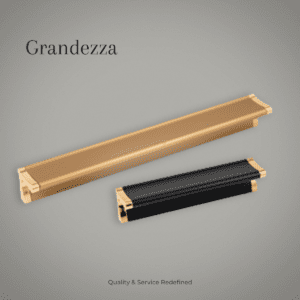Furniture handles might seem like minute details in the grand scheme of interior design, but they play a pivotal role in both functionality and aesthetics.
Often overshadowed by the prominence of furniture pieces, these handles serve as connectors between users and their furniture, making their selection a decision that requires thoughtful consideration.
The Duality of Furniture Handles
Functionality: Beyond the Surface
Furniture handles, also known as knobs or pulls, are more than just decorative elements. They are functional components that facilitate interaction with furniture. Consider the ergonomics—how easily does the handle allow for gripping and pulling?
Is it suitable for the intended use and environment? For instance, kitchen cabinet handles need to withstand frequent use and potential grease accumulation, requiring materials and designs that are easy to clean and durable.
Aesthetics: Making a Statement
Conversely, these handles contribute significantly to the visual appeal of furniture. They act as subtle accents that can elevate the overall design. A sleek, minimalist handle on a modern cabinet can exude sophistication, while an ornate, vintage-inspired handle on a dresser can add a touch of nostalgia. Aesthetics encompass shape, material, finish, and how the handle complements the furniture’s design language.
Striking the Balance: Importance and Challenges
Coherence in Design
Choosing the right handle involves a delicate balance between functionality and aesthetics. A handle might be visually stunning, but if it compromises ease of use or clashes with the furniture’s overall style, it could disrupt the design harmony. Conversely, a purely functional handle might undermine the furniture’s aesthetic appeal.
Consideration of Materials and Finishes
Materials and finishes are crucial aspects. They must align not only with the furniture’s design but also with the intended use and maintenance requirements. Brass or stainless steel handles might exude luxury, but they could be impractical in environments prone to corrosion or wear. Wood or ceramic handles, while visually appealing, might not withstand heavy use.
Harmonising with the Furniture
The handle should complement the furniture’s design, whether it’s contemporary, classic, industrial, or eclectic. A mismatch in style can create visual dissonance. For instance, a sleek, modern handle might clash with the ornate detailing of a vintage-inspired piece, disrupting the overall aesthetic.
Achieving Harmony in Design
Understanding the Context
Start by understanding the furniture’s purpose, the room’s design theme, and the users’ needs. This insight will guide the selection process, ensuring that both functionality and aesthetics align seamlessly.
Testing and Experimentation
Experiment with various handle styles, shapes, and materials. Sometimes, unexpected combinations can create striking visual effects while maintaining functionality. Mock-ups or digital renderings can offer a preview of how different handles will look on the furniture.
Embracing Versatility
Opt for versatile designs that strike a balance between form and function. Handles that blend with various design styles offer flexibility, allowing for seamless integration into different spaces.
Customization and Personalization
Consider customization options if available. Tailoring handles to specific needs and design preferences ensures a perfect fit for the furniture and the overall design scheme.
In the world of interior design, where every detail contributes to the whole, the selection of furniture handles holds substantial significance. Balancing functionality and aesthetics in these seemingly small components can elevate the entire design, creating a cohesive, visually pleasing, and user-friendly environment.
Finding the sweet spot where form meets function is the key to unlocking the true potential of furniture handle selection.
Ultimately, the pursuit of harmony in furniture handle selection isn’t just about choosing what looks good or works well—it’s about finding the delicate equilibrium that enhances the user experience while seamlessly integrating with the furniture’s design language.





